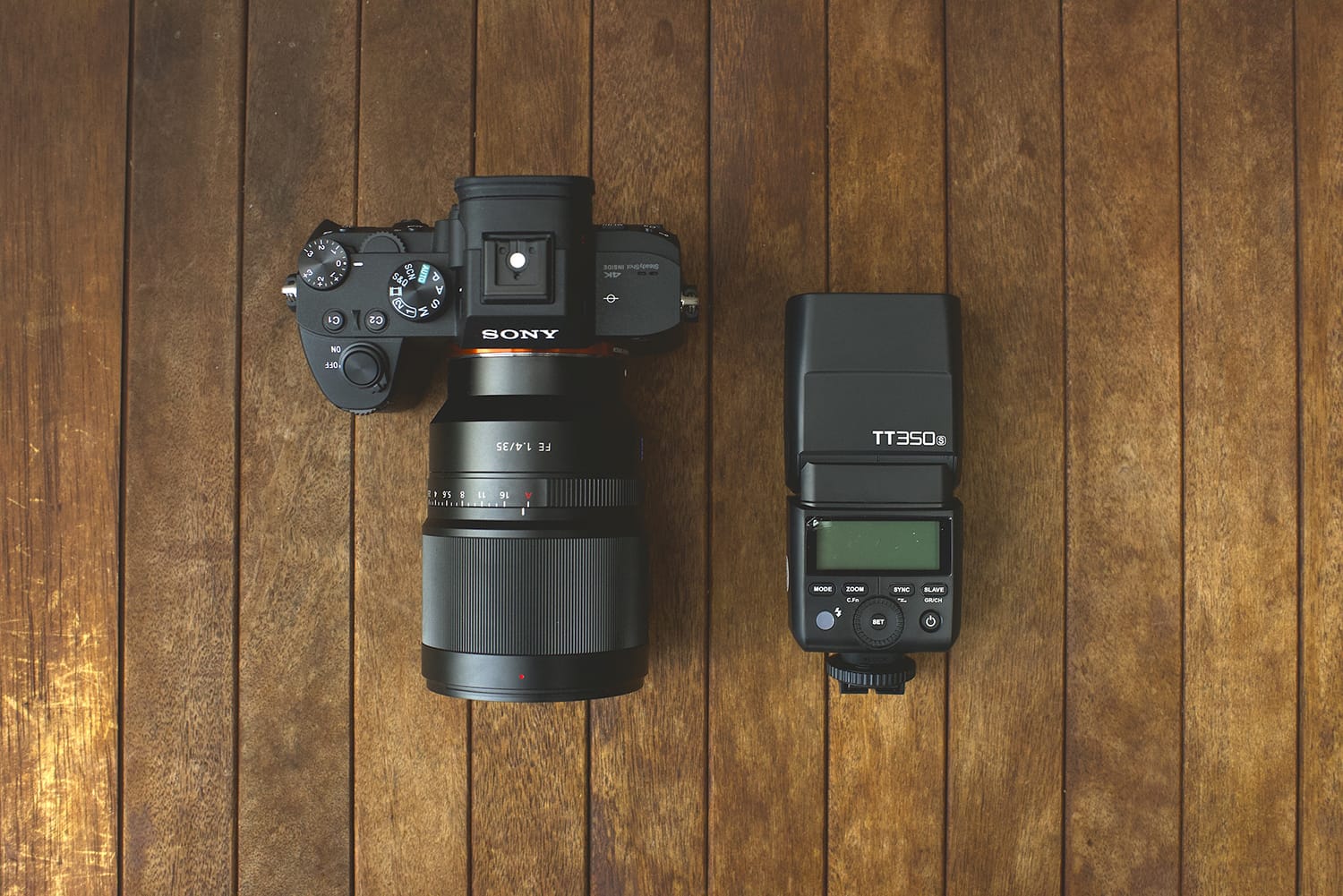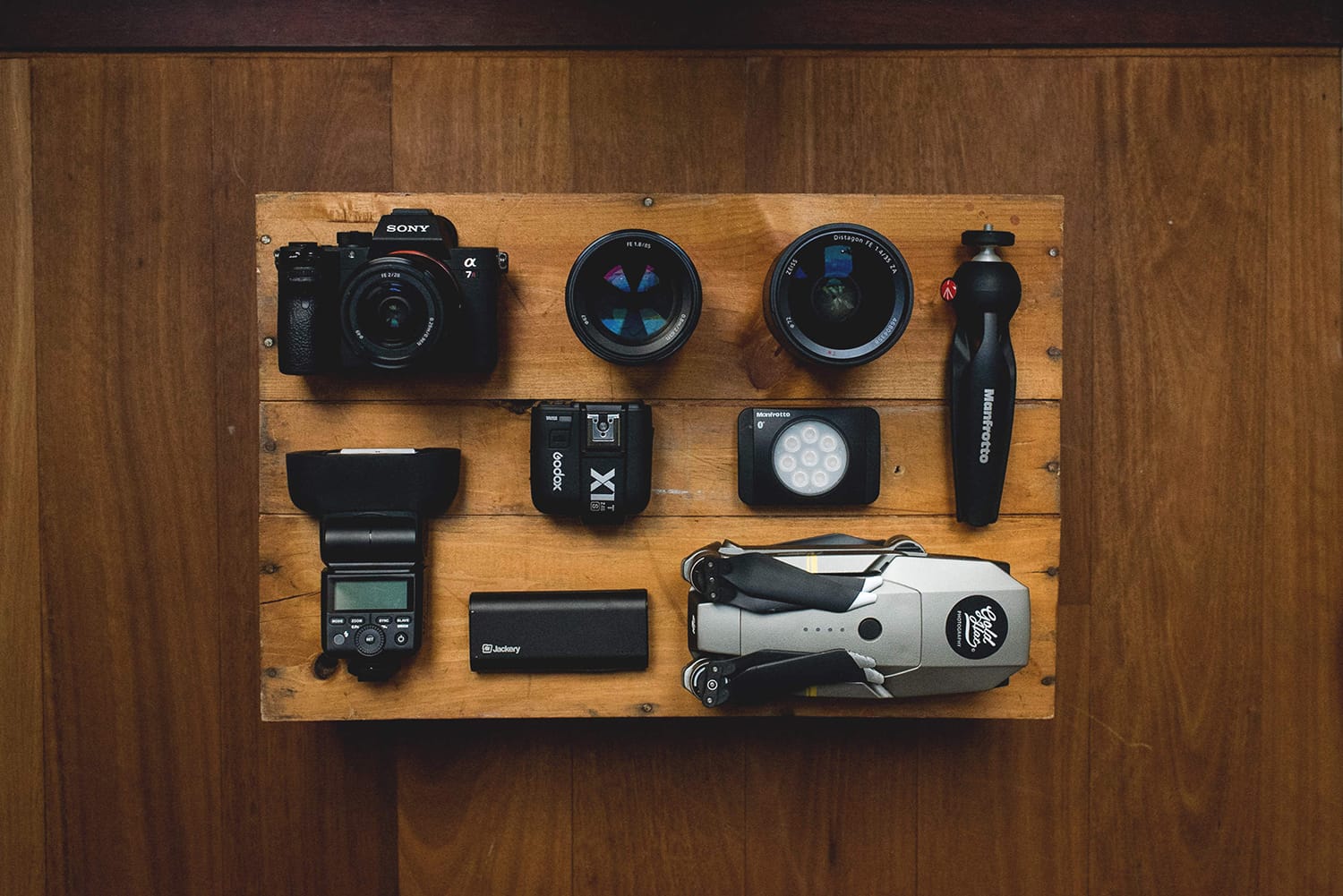The Ultimate Minimalist Wedding Photography Setup
I would like to start with a somewhat broad generalisation. Photographers love gear. Yes, G.A.S. is unpleasant, and I definitely don’t advocate the acquisition of new camera gear just for the sake of it.
However, often it’s the acquisition and use of new gear that motivates and inspires us to create things we may never have otherwise, had it not been for the latest splurge on a new toy.

As for us wedding photographers, getting our grubby mitts on new gear can be hugely beneficial. Sometimes all it takes is a new lens or a new gadget to reinvigorate our passion mid-season, reminding us how fun it is, and how lucky we are to do what we do.
Despite 4 years of wedding photography, I haven’t fiddled with my camera gear to shoot weddings all that much. From a heavy-weight start with DSLRs and the f/2.8 zooms, to a quick switch to prime lenses, I’ve tried to keep the contents of my camera bag a relatively simple affair.
A wedding photographer running a site like Shotkit is a little like an alcoholic running a liquor shop, so I need to keep a tight rein on things! Not only do I have photographers sending me pretty pictures of their gear collections every day, but I’m also in the rather enviable position of having access to any product in the industry.
A loaner of $10k worth of digital MF camera gear? One email away. The latest luxury camera bag? Sure, and feel free to keep it.
Sounds fun, right? Alcoholic in a liquor shop…
Even though I love trying out the latest gear, I’m also a minimalist at heart. Or at least, I aspire to be one. At home, unless something is in use, it’s moments away from either eBay or the bin. It drives my wife nuts…
So, back to the topic of this article – I believe that despite the plethora of tempting gear flying my way every day, I’ve whittled my arsenal down to what I believe is the ultimate minimalist wedding photography set up. Let me talk quickly about how I came to this conclusion.
Having shot DSLRs professionally since day one, I finally dipped my toes into the world of mirrorless (for professional use) earlier this year. My move there wasn’t the temptation of smaller bodies or improved focus abilities, but rather one of pure laziness – I’d found that when shooting with my D750, I was using the Live View more and more to shoot static subjects.
I was growing tired of looking through the OVF to see a world that would change the moment I clicked the shutter and viewed the image on the camera’s rear LCD. Why not see the image you’re about to take before you press the shutter button?
Maybe it’s laziness, maybe it’s efficiency, but whatever the case, the future is definitely mirrorless. I call it ‘WYSIWYG Photography’…
The Sony a7RIII was an easy choice after all the glowing online reviews, and the switch provided the perfect opportunity to completely rethink my approach to gearing up for a wedding.
Up until this point, I’d been like every other quasi-hipster-wedding-photographer in the industry, tooled up with a dual leather camera strap and two prime-lensed cameras swinging beside my hips.
I loved the experience of pulling on my MoneyMaker come ceremony time, like a soldier going to battle… those heavy-duty metal clips… clunk… clunk… cameras locked and loaded. The wedding photographer’s pre-game ritual.
With a 35mm attached to one camera and an 85mm on the other, I was ready for anything. The 24mm in my bag was just in case we stumbled across any epic landscapes, and the 50mm in my car was for when disaster struck and all my other lenses would fall down a crack in the ground during an earth quake.
Oh, and for when night came, I was ready with my flashes, LEDs and modifiers galore… In short, I never wanted to be in a position at a wedding without the exact tools for the job.
When I switched camera systems, it was like a light-bulb moment for me. But what if I don’t actually need any of this extra gear? After 250 weddings, how much of this gear am I actually using?
I took a big step back from my over-stuffed rolling camera bag, and starting pulling things out. I realised that the only time I used two cameras at once was during the ceremony, a mere 10% of the day, and even then, my usage of the 85mm was limited to just a handful of ‘lazy’ shots.
Did I really need to have that much distance between myself and the subject? Or could I walk closer, or… horror of horrors… crop?!
With the Sony a7RIII and its 42.4MP, I knew I’d have ample legroom to crop to my heart’s content. I could also set up a custom button to control an in-camera APS-C simulation, turning my 35mm field of view to around 50mm in an instant. Then if I needed, I could still crop into that in post. Hmm… time to retire that 85mm!
The next wedding, I experimented. One 35mm lens, all day long. I walked closer when needed, used my secret in-camera cropping weapon when 35 felt too wide, and even cropped the odd photo in Lightroom… and you know what? It felt good.
Something else I’d blindly adopted was the whole dual-camera set up thing. Sure, two cameras at each side with different lenses is practical in some ways, but can also be rather annoying. Whilst navigating tight wedding venues, I often found myself more conscious of what the other (hanging) camera was doing than what I was shooting.
Then I realised something else. If I wasn’t using two cameras at the same time, was it really necessary to own two of exactly the same camera?
Switching systems forces you to re-evaluate every purchase to question whether its still necessary to get the job done. Purchasing one expensive mirrorless camera made me realise that I didn’t need to sell off my ageing D750 – now I keep it instead as my backup camera, with a lightweight Nikon 35mm f/1.8 attached.
A mirrorless and DSLR hybrid setup?!, I hear you gasp. If disaster struck, would my brain really be able to handle my dinosaur-DSLR’s OVF again?! Would my client be able to tell that half the photos were taken with a different camera?! I don’t think I need to answer that…
As for lighting, much of this comes down to personal preference. I’d struggled with high ISOs and natural light enough during my years shooting weddings in dark venues to know that a little artificial light is a necessary evil.
In the past, Profoto had been kind enough to send me one of their gorgeous A1 strobes to trial. The device itself is a work of art – simply turning it on is a pleasure, and I felt like I was using the Louis Vuitton of on-camera flashes.
However, it also made my smaller-bodied camera feel unwieldy and top-heavy, making the dance floor portion of the wedding day a chore. By this stage of the night, I want to be using the lightest, most agile set up possible, and this definitely was not it.
Off-camera the A1+Air Remote worked flawlessly, but this wasn’t a huge selling point for me. I can always live with the occasional misfire of cheaper triggers.
As for LEDs, it’s nice to have the luxury of a continuous light source to fall back on. As well as being good in a pinch for the first-dance, the old ‘rim-light behind the couple’ night portrait is a great way to end a wedding, with something creative and unexpected for the couple. I decided to keep a small one that Manfrotto had gifted me in my kit.
So with my tiny third party flash in the bag and a spare in the car, an equally tiny trigger and a pocket sized LED, I could now fit all my gear and a packed lunch in to my small, Bilingham shoulder bag (I’m a Brit after all!).
A quick run down of my minimalist wedding gear set up:
- Bilingham Hadley Pro bag
- Sony a7RIII body + spare battery
- Sony 35mm f/1.4 lens
- Godox TT350X flash
- Godox X1T trigger
- Manfrotto LumiMuse 3 light
Even though the trigger and LED are unnecessary to carry out my job, they weigh next to nothing, so they can come along for the ride. I also chucked in a mini tripod and a Mavic Pro Platinum, definitely not essential items but they do tend to expand creative photography options.

As for backup gear, it would be foolish and unprofessional to ignore worst-case-scenarios just for the sake of creating a minimalist setup. In my car I have another bag containing a Nikon D750 body, Nikon 35mm f/1.8 lens and Nikon SB-710 flash, all of which I’m happy to say is all gathering dust.
Minimalism in all aspects of life is a hugely freeing experience. Sure, it may not be necessary, or even suitable for everyone, let alone wedding photographers who like to have the right gear for every eventuality.
I also believe that minimalism just for the sake of minimalism isn’t entirely necessary with photography. If a piece of new gear inspires us to create, or helps us get a shot we may not have got otherwise, by all means let’s do some shopping! I’m definitely not averse to trying out some new toys…
However, I do recommend that you experiment a little with your current gear set up, and give some thought to how you’ve been shooting weddings up until now.
If your brain is anything like mine (i.e. worn out!), having less gear means less complications, and more freedom for lateral thinking during the hectic wedding day, and hopefully for more creativity… which is after all, what we’re all striving for.
